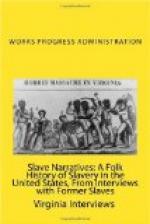“I was born in Raleigh, North Carolina in 1850. My father was born in Baltimore, Maryland. My mother and father was sold into Bibb County, Georgia. I don’t know how much they sold for. I don’t know how much they paid for them. I don’t know how much the speculator asked for them. Used to have them in droves and you would go in and pick ’em out and pay different amounts for them.
“I was never sold. My old boss didn’t believe in selling slaves. He would buy ’em but he wouldn’t sell ’em. I’ll say that much for him.
Master
“I belonged to a man named Thomas Johnson Cater.
Houses
“They lived in log houses. Some of them had weatherboard houses but the majority of them was log houses. Two doors and one window. Some of them had plank floors. Some of them had floors what was hewed, you know, sills. They had stick and dirt chimneys. Some of them had brick chimneys. It depended on the master—on the situation of the master.
Furniture
“They just had bunks built up side the wall. The best experienced colored people had these teester beds. Didn’t have no slats. Had ropes. They called ’em cord beds sometimes. They had tables just like we have now what they made themselves. Chairs were long benches made out of planks. Little kids had big blocks to sit on where they sawed off timber.
“They had what they called a cupboard to keep the food in. Some of them had chests made out of planks, you know. That is the way they kept it. They put a hasp and steeple on it so as to keep the children out when they was gone to the field.
Food
“They give ’em three pounds of meat a week, peck of meal, pint of molasses; some of them give ’em three to five pounds of flour on a Sunday morning according to the size of the family. The majority of them had shorts from the wheat. Some of the slaves would clean up a flat in the bottoms and plant rice in it. That was where they would allow the slaves to have truck patches.
“Some few of them had chickens that was allowed to have them. Same of them had owners that wouldn’t allow their slaves to own chickens. They never allowed them to have hogs or cows. Wherever there was a family that had a whole lot of children they would allow them to have a cow to milk for to get milk for their children. They claimed the cow, but the master was the owner of it. It belonged to him. He would just let them milk it. He would just let them raise their children off of the milk it gave.
Clothes
“There was no child ever had a pair of shoes until he got old enough to go in the field. That was when he was twelve years old. That is about all I know about it.




